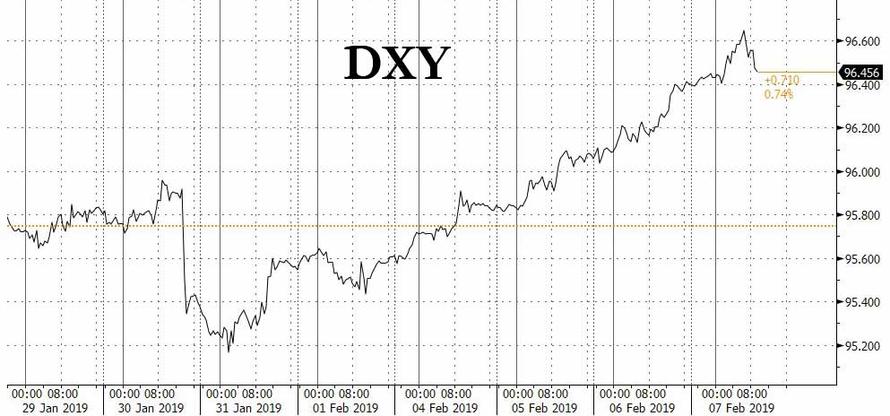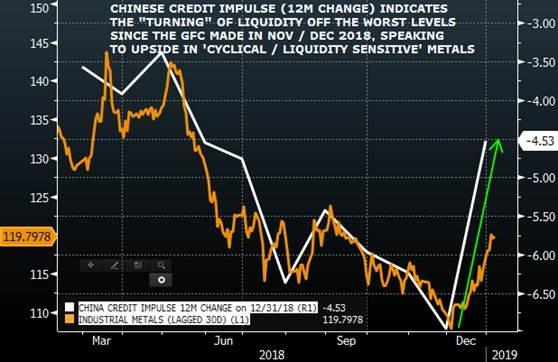Is the torrid 6-week rally that started on December 26 finally, and led to the best January performance since 1987, finally over?
That is the second lingering question traders would like answered this morning (the first one being just what caused the dramatic plunge in USD libor overnight).
Indeed, after what seems like weeks of calls for a pause and retest of the rebound rally, it looks like stocks are ready to give it a go, according to Bloomberg’s Andrew Cinko who notes that the “turgid growth forecasts for the UK and euro-area are a good enough excuse to step back today and let prices contract” and adds that enthusiasm for equities certainly appears to have waned given “tepid U.S. composite trading volume and the lack of price movement intraday.”
Not that there aren’t tactical reasons for the sudden shift in sentiment, with Nomura’s Charlie McElligott highlighting the latest “growth scare” pile-on, including:
- the EC slashes their Euro-Area growth- and inflation- forecasts
- the RBI shock with a surprise rate cut earlier overnight, just one day after an RBA banker pivoted hard from hawkish to neutral earlier in week, which in turn followed a surprisingly hawkish RBA statement
- the BoE too cut their forecasts as well, showing the scale of the slowdown fear, permeating global central banks
What does this mean? According to McElligott the tactical implication is that the 2018 “hawkish normalization era” is long-gone, and instead we have resumed the “race to zero” posture, as globally, central banks scramble to be “more dovish” than their neighbor, which is also driving further USD strength, as the by-far “best of an ugly bunch.”
In the meantime, Nomura notes that amid this latest global growth scare, fixed-income has accelerated its rally, with German Bunds making new contract highs after the European outlook cut headlines, while Equities and growth-sensitives (commodities/Risk FX/EM FX) sell-off, tied to this ongoing USD strength. Also of note, the previously discussed – and unexplained – sharp plunge in 3M USD Libor, which saw its biggest fixing drop since Mary 2009.
A few more observations from Nomura on the recent surge in the dollar, which has seen a “a huge reversal to the upside” with the DXY +1.4% since the day following the Fed’s dovish pivot, as the rest of world joins the parade in what looks to be a “race to the bottom” as noted above in bullet 2.
This “TINA” dynamic with US Dollar is, without a doubt, the largest hindrance to “weak USD” consensus view in most 2019 forecasts, McElligott’s included –as the global slowdown and idiosyncratic issues again “force” Dollar stickiness as “the cleanest dirty shirt” of the bunch.
As such, at least over the short term, the key catalyst to watch closely is the Dollar (and US rates) to determine if the consensus trade of early 2019 disintegrates, resulting in further risk assets weakness, as global economic headwinds force traders to rush into the safety of the greenback.
* * *
While the above may explain the tactical considerations for stocks, and why a drop in the S&P may be in the offering, what about the strategic factors? Here McElligott makes the following key point, whose punchline is that going forward the only thing that matters is inflation, and when it comes back:
- After ruminating on Powell since last week (and Fed speakers since the blackout was lifted), it has become clear to me that the Fed is now a “one trick pony,” with broad “data dependence” a myth in my eyes, and instead, now just a singular focus on INFLATION as their lone mandate
- A point that I have made over the better part of the past year is best expressed through asking a simple question: “What was the catalyst that awoke last year and drove the new cross-asset volatility regime?”
- My answer: “green shoots” on INFLATION is what shook markets and instituted the new volatility paradigm witnessed in 2018, where the “match” of explosive US fiscal stimulus onto an already “full steam ahead” US economy (which was running above-trend growth already) lit the US Rate Vol “fire,” and meant that for the first time in the post GFC regime, traders lost their visibility on the future path of US interest rates…especially as we saw a new Fed Chair enter the arena with perceived “hawkish” chops
- As I have previous made clear, the late December 2017 / January 2018 “spot (S&P) up, VIX up” environment was a rather profound signal for the imminent “tipping over” of risk, and the catalyst of this volatility was the move in US Rate Vol (UST 10Y term premium from at the time near-cycle lows of -60 on Dec 15th 2017 up to just -14bps by Feb 9th 2018 / 3m10Y USD Swaption Vol from 52.3 on Dec 13th 2017 to 74bps on Feb 6th 2018)
- Why did Rate Vol “suddenly” reappear then? My prior point on Inflation, which had been dismissed as an afterthought over the prior 8+ years…but across the month of January 2018, we saw US CPI MoM beat, a number of very large regional Fed “Prices Paid” beats, and ultimately a shock beat in US AHE YoY
- The final “wage inflation” surprise signaled from the AHE YoY suddenly saw the long-dormant “Philips Curve” argument brought back to life as the seeming “death blow” to the “Goldilocks” narrative—and occurred on February 2nd, which saw the S&P 500 trade -2.4% on the session thereafter and more-glaringly, the leveraged VIX ETN “extinction event” on the trading day following (2/5/18), as S&P turned to dust, -5.4% on the day
- Fast-forward to the “now”—we are seeing “short volatility” positions re-established in earnest (systematic vol strats back in “roll-down” mode / “short vega” again for the first time in 4+ months), along with the general view from fundamental investors that the Fed is “out of the picture” for the next 5-6 months, and with perceived certainty that the next move thereafter is to EASE—all in-light of a group-think view that “INFLATION IS DEAD”
- As such, a reacceleration in inflation is without question the largest downside risk to the stock market—with regards to the view that inflation beat(s) / wages & earnings beat(s) would then see the Fed forced back-into the picture, and mean we are back on the “tighter financial conditions” / 2018 regime hamster-wheel again in that scenario—all tied to this implicit linkage between the reacceleration of “short volatility” positioning and a consensual view on slowing-inflation
With this in mind, and as concerns for a renewed drift lower in stocks bubble up, what could be the catalyst for inflation upside surprise? As MCElligott explained yesterday, one place where a global reflation wave could emerge from is the Chinese “liquidity- / credit- impulse”, which he is “keenly watching” for signs of continued pivot higher that could bleed-through into global inflation expectations.
To be sure, this sharp rebound in the “Chinese Liquidity- and Credit- Impulse” is currently evidencing itself in Shanghai Commodities Future YTD performance (Nickel +11.6%, Zinc +6.0%, Bitumen 22.9%, Fuel Oil +19.4%, Deformed Bar +6.7%, Wire Steel +8.7% and Qingdao Iron Ore +15.1% YTD).
While it remains to be seen if China can sustain this bounce in credit conditions, if the answer is yes, and if China’s latest reflation attempt spills over across the Atlantic and impacts the US, then watch out below as the Fed will now be truly trapped between the threat of sliding risk assets on one hand, and a tidal wave of new Chinese inflation set to arrive on US shores.
via ZeroHedge News http://bit.ly/2TBMZNP Tyler Durden

